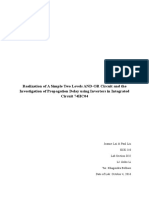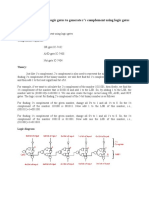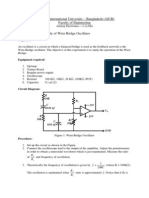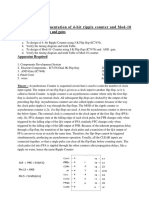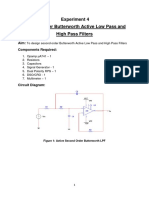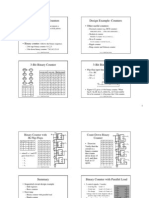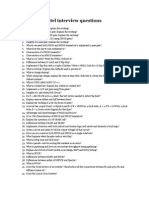Experiment 9 (Flip Flops)
Experiment 9 (Flip Flops)
Uploaded by
groupidb3Copyright:
Available Formats
Experiment 9 (Flip Flops)
Experiment 9 (Flip Flops)
Uploaded by
groupidb3Original Title
Copyright
Available Formats
Share this document
Did you find this document useful?
Is this content inappropriate?
Copyright:
Available Formats
Experiment 9 (Flip Flops)
Experiment 9 (Flip Flops)
Uploaded by
groupidb3Copyright:
Available Formats
ACROPOLIS TECHNICAL CAMPUS, INDORE 452020
Department of Electronics & Communication Engineering Lab Session No. 10 Page No.1/7 Digital Circuits & System CS - 303 Enrolment No. 0875 Batch No.
Performance Evaluation:
Name
Performing on Extra regular First Submission Second Submission
Grade and Remarks by the Tutor 1. Clarity about the objective of the experiment 2. Clarity about the problem statement 3. Submitted the work in desired format 4. Shown capability to solve the problem 5. Contribution to the team work. Others:
Grade
Signature
1.
Title: To perform and analyze various flip flops and observation of race around condition. Aims:
a) b) c) d) To understand the logical operation of flip flop. To verify the truth table of S-R,J-K ,D and T flip-flop. To study about Master-slave J-K flip-flop. To analyze the digital 74XX IC series of flip-flop.
2.
3. Objectives: After completing the experiment, the student should be able:
a. To be able to identify each flip-flop by their IC, Pin configuration and inputoutput pins . b. To draw any sequential circuits using J-K flip flop. c. To be able to design shift register and counter using flip flops .
4. Problem Statement:
a) To convert SR flip-flop into JK flip-flop. b) To design a 4-bit bidirectional shift register using D- flip-flop. c) To make a 4-bit ring counter using J-K flip-flop.
5. Equipments:
DIT board, IC 7476, IC 7474 and its power supply.
ACROPOLIS TECHNICAL CAMPUS, INDORE 452020
Department of Electronics & Communication Engineering Lab Session No. 10 Page No.2/7 Digital Circuits & System CS - 303 Enrolment No. 0875 Batch No.
6. Theory:
S-R Flip-Flop A flip-flop circuit can be constructed from two NAND gates or two NOR gates. These flipflops are shown in Figure 2 and Figure 3. Each flip-flop has two outputs, Q and Q', and two inputs, set and reset. This type of flip-flop is referred to as an SR flip-flop or SR latch. The flip-flop in Figure 2 has two useful states. When Q=1 and Q'=0, it is in the set state (or 1state). When Q=0 and Q'=1, it is in the clear state (or 0-state). The outputs Q and Q' are complements of each other and are referred to as the normal and complement outputs, respectively. The binary state of the flip-flop is taken to be the value of the normal output. When a 1 is applied to both the set and reset inputs of the flip-flop in Figure 2, both Q and Q' outputs go to 0. This condition violates the fact that both outputs are complements of each other. In normal operation this condition must be avoided by making sure that 1's are not applied to both inputs simultaneously.
The NAND basic flip-flop circuit in Figure 3(a) operates with inputs normally at 1 unless the state of the flip-flop has to be changed. A 0 applied momentarily to the set input causes Q to go to 1 and Q' to go to 0, putting the flip-flop in the set state. When both inputs go to 0, both outputs go to 1. This condition should be avoided in normal operation. Jk Flipflop: Fig 7(a) shows the clocked J-K flip-flop with clear (CR) and preset (PR) inputs. The small circle (inversion symbols) on these inputs indicates that logic 0 is required to clear or set the flip-flop. Thus the 0 applied to the clear input will reset the flip-flop to Q = 0, and a 0 applied to the Preset input will set the flip-flop to Q = 1. These inputs override the clock & J-K input. I.e. a 0 applied to the clear input will reset the flip-flop regardless of the values of J-K, and the clock. Under normal conditions, a 0 should not be applied simultaneously to clear and preset. When the clear and preset inputs are both held at logic 1, the J, K and clock inputs operate in the normal manner.Fig.8 (b) shows the truth table for J-K Flip-Flop.
ACROPOLIS TECHNICAL CAMPUS, INDORE 452020
Department of Electronics & Communication Engineering Lab Session No. 10 Page No.3/7 Digital Circuits & System CS - 303 Enrolment No. 0875 Batch No.
ACROPOLIS TECHNICAL CAMPUS, INDORE 452020
Department of Electronics & Communication Engineering Lab Session No. 10 Page No.4/7 Digital Circuits & System CS - 303 Enrolment No. 0875 Batch No.
Master Slave JK Flip-Flop J-K Flip-Flop suffers from timing problems called "race" if the output Q changes state before the timing pulse of the clock input has time to go "OFF". To avoid this the timing pulse period (T) must be kept as short as possible (high frequency). As this is sometimes is not possible with modern TTL IC's the much improved Master-Slave JK Flip-flop was developed. This eliminates all the timing problems by using two SR flip-flops connected together in series, one for the "Master" circuit, which triggers on the leading edge of the clock pulse and the other, the "Slave" circuit, which triggers on the falling edge of the clock pulse. The Master-Slave Flip-Flop is basically two JK bistable flip-flops connected together in a series configuration with the outputs from Q and Q from the "Slave" flip-flop being fed back to the inputs of the "Master" with the outputs of the "Master" flip-flop being connected to the two inputs of the "Slave" flip-flop as shown below. Master-Slave JK Flip-Flops
FIG. 8(c) logic diagram for master slave JK flip-flop
Fig.8(c) shows one way to build a JK master-slave flip-flop. It provides another way to avoid racing. Heres how it works. To begin with, the master is positive edge triggered and the slave, negative edge triggered. Therefore, the master responds to its J and k inputs before the slave. If J =1 and K = 0, the master set on positive clock edge. The high Q output of the master drives the J input of the slave, so when the negative clock edge hits, the slave sets, copying the action of master. If J = 0 and k = 1, the master reset on leading edge of the clock. The high Q output of the master goes to the K input of the slave. Therefore, the arrival of the clocks trailing edge forces the slave to reset. Again, the slave has copied the master. If the masters J and K input are both High. It toggles on the positive edge and the slave then toggles on the negative clock edge. Regardless of what the master does, therefore, the slave copies it: if the master sets, the slave sets; if the master reset, the slave resets. The timing relationship is shown in Fig.8 (d) and is assumed that the flip-flop is in the clear state prior to the occurrence of the clock pulse. The output state of the master-slave flip-flop occurs on the negative transition of the clock pulse. Some master-slave flip-flops change output state on the positive transition of the clock pulse by having an additional inverter between the CP terminal and the input of the master.
ACROPOLIS TECHNICAL CAMPUS, INDORE 452020
Department of Electronics & Communication Engineering Lab Session No. 10 Page No.5/7 Digital Circuits & System CS - 303 Enrolment No. 0875 Batch No.
Fig.8 (d) Timing relationship in a master slave flip-flop
D Flip-Flop As seen from the truth table Fig.8 (f), the state of this flip-flop after the clock pulse Q (t+1) is equal to the input D before the clock pulse. For example, if D = 1 before the clock pulse, Q = 1 after the clock pulse regardless of the previous value of Q. therefore, the characteris tic equation is Q (t+1) = D.
T Flip-Flop T flip-flop A clocked Flip-Flop whose output toggles, i.e. changes to the complementary logic state, on every active transition of the clock signal. The device acts as a divide-by-two counter since two active transitions of the clock signal generate one active transition of the output. It can be considered as being equivalent to a J-K Flip-Flop whos J and K inputs are held at logic 1. This type of flip-flop is a simplified version of the JK flip-flop. It is not usually found as an IC chip by itself, but is used in many kinds of circuits, especially counter and dividers. Its only function is that it toggles itself with every clock pulse (on either the leading edge, on the trailing edge) it can be constructed from the JK flip-flop as shown in Fig.8 (g).
ACROPOLIS TECHNICAL CAMPUS, INDORE 452020
Department of Electronics & Communication Engineering Lab Session No. 10 Page No.6/7 Digital Circuits & System CS - 303 Enrolment No. 0875 Batch No.
This flip flop is normally set, or loaded with the preset and clear inputs. It can be used to obtain an output pulse train with a frequency of half that of the clock pulse train, as seen from the timing diagram, in this example, the T flip flop is triggered on the falling edge of the clock pulse.
7. Procedure :
A) S-R Flip-Flop Connect the logic signals from the logic input switches to S and R input of R-S Flip-Flop. Observe the logic outputs on the LEDs in O/P section. Verify the truth table of RS flip-flops.
ACROPOLIS TECHNICAL CAMPUS, INDORE 452020
Department of Electronics & Communication Engineering Lab Session No. 10 Page No.7/7 Digital Circuits & System CS - 303 Enrolment No. 0875 Batch No.
B) J-K Flip-Flop Note: use any one of the gate available out of 4. Connect PR to PRESET, CR to CLEAR and J and K terminals to the logic input switches. Connect CLK of JK flip-flop to Clock terminal. Connect Q and /Q terminals to LED indicators in O/P section. Set the PR, CR, CLK, J and K Signals by means of the switches as per the truth table of JK flip-flop given above and verify the Q and /Q outputs by changing possible input conditions. C) Master Slave J-K Flip-Flop Note: use any two of the gate available out of 4. Do the connection for MS JK Flip-Flop as shown in Fig.7(c) above. Connect PR to PRESET, CR to CLEAR of both the flip-flops and J and K terminals of master flip-flop to the logic input switches. Connect CLK of master JK flip-flop to Clock terminal. Connect Q and /Q terminals of slave flip-flop to LED indicators in O/P LED section. Also connect Q & /Q terminals of master flip-flop to the leds in O/P LED section. Set the PR, CR, clk, J and K Signals by means of the switches as per the truth table of MS JK flip-flop given above and verify the Q and /Q outputs. D) D Flip-Flop Note: use any one of the gate available out of 2. Connect PR to PRESET, CR to CLEAR and D terminals to the logic input switch. Connect the CLK of D Flip-Flop to CLOCK terminal. Connect Q and /Q terminals to LED indicators in O/P LED section. Set the PR, CR, CLK and D Signals by means of the switches as per the truth table of D flip-flop given above and verify the Q and /Q outputs. E) T Flip-Flop Note: use any one of the gate available out of 4. Do the connection for T Flip-Flop as shown in FIG.7 (g) above. Connect PR to PRESET, CR to CLEAR and T terminals to the logic input switch. Connect the CLK of T Flip-Flop to CLOCK terminal. Connect Q and /Q terminals to LED indicators in O/P LED section. Set the PR, CR, CLK and T Signals by means of the switches as per the truth table of T flipflop given above and verify the Q and /Q outputs.
Prepared by Megha Motta
Date
Modified on
You might also like
- Lab Report On ECE 210 Lab1Document6 pagesLab Report On ECE 210 Lab1Joanne Lai100% (3)
- Flip Flops and Counters: Digital Logic Design LaboratoryDocument16 pagesFlip Flops and Counters: Digital Logic Design LaboratoryTrương Quang Tường100% (1)
- Multistage AmplifierDocument18 pagesMultistage AmplifierSai Sadiq100% (2)
- De Lab PDFDocument36 pagesDe Lab PDFPadmasri GirirajanNo ratings yet
- Digital Lab ManualDocument57 pagesDigital Lab ManualSUSISATYANo ratings yet
- Study of Flip-Flops Submitted To: Submitted byDocument10 pagesStudy of Flip-Flops Submitted To: Submitted byIrene Sultana100% (1)
- Expt 5 Encoder DecoderDocument3 pagesExpt 5 Encoder DecoderKathirvelu DhandapaniNo ratings yet
- 2s Complement ManualDocument2 pages2s Complement ManualSRUJANA VNo ratings yet
- Lab Report Electronics 5thDocument18 pagesLab Report Electronics 5thMuhammad kawish iqbal100% (1)
- NOT Gate Transistor Complete PDFDocument3 pagesNOT Gate Transistor Complete PDFSarkaraliNo ratings yet
- Experiment-7 Design A Binary Subtractor Circuit Half and Full Subtractor 7-1 ObjectDocument4 pagesExperiment-7 Design A Binary Subtractor Circuit Half and Full Subtractor 7-1 ObjectMohammed Dyhia AliNo ratings yet
- Experiment PE LABDocument5 pagesExperiment PE LABsureshfm1100% (2)
- Implementation of NAND NOR AND Gates Using TTL - Asadullah Hussain & Faizan KhalidDocument7 pagesImplementation of NAND NOR AND Gates Using TTL - Asadullah Hussain & Faizan KhalidchachunasayanNo ratings yet
- BJT Lab ReportDocument3 pagesBJT Lab ReportAkib Hasan NiloyNo ratings yet
- Experiment # 5 To Examine The Diode Applications As: Diode Clippers/LimitersDocument3 pagesExperiment # 5 To Examine The Diode Applications As: Diode Clippers/LimitersSaad khanNo ratings yet
- Chapter 5 HW Solution: Review QuestionsDocument6 pagesChapter 5 HW Solution: Review QuestionslgNo ratings yet
- Module - 3 DSDVDocument40 pagesModule - 3 DSDVHimabindu SanapaNo ratings yet
- Practical No 7:-Demultiplexer (DEMUX)Document3 pagesPractical No 7:-Demultiplexer (DEMUX)vaishnaviNo ratings yet
- Experiment No: 04 Experiment Name: Summing Amplifire. Aim: To Design and Setup A Summing Amplifier Circuit With OP AMPDocument4 pagesExperiment No: 04 Experiment Name: Summing Amplifire. Aim: To Design and Setup A Summing Amplifier Circuit With OP AMPjif 1310No ratings yet
- Multiplexer & DemultiplexerDocument23 pagesMultiplexer & DemultiplexerVarunNo ratings yet
- De Lab ManualDocument42 pagesDe Lab ManualAnjali KumariNo ratings yet
- Monostable Multivibrator Using 555 Timer AimDocument4 pagesMonostable Multivibrator Using 555 Timer Aimneha yarrapothuNo ratings yet
- AIM OF THE EXPERIMENT: To Study The Frequency of Colpitt's Oscillator. ApparatusDocument2 pagesAIM OF THE EXPERIMENT: To Study The Frequency of Colpitt's Oscillator. ApparatusHimansu Sekhar SahuNo ratings yet
- Lecture 12 Binary Adder-SubtractorDocument8 pagesLecture 12 Binary Adder-SubtractorSasi Kiran SNo ratings yet
- Experiment-1 Sample and Hold Circuit Using OpampDocument45 pagesExperiment-1 Sample and Hold Circuit Using OpampSavita Kiran BNo ratings yet
- American International University-Bangladesh: Title: Design of A Half, Full and Parallel Adder and Subtractor CircuitsDocument4 pagesAmerican International University-Bangladesh: Title: Design of A Half, Full and Parallel Adder and Subtractor CircuitsAbid ChowdhuryNo ratings yet
- Andersons BridgeDocument3 pagesAndersons BridgeRamesh KumarNo ratings yet
- DLD-EXP 01 (Studying Different Digital Integrated Circuits (ICs)Document14 pagesDLD-EXP 01 (Studying Different Digital Integrated Circuits (ICs)SifatNo ratings yet
- Lab Manual EC II Format 2Document53 pagesLab Manual EC II Format 2nishavs100% (1)
- Half Subtractor and Full Subtractor VHDL Simulation CodeDocument7 pagesHalf Subtractor and Full Subtractor VHDL Simulation Codearup duttaNo ratings yet
- Flip Flop ExperimentDocument5 pagesFlip Flop ExperimentDeepak KumbharNo ratings yet
- 3.analysis of Class B AmplifiersDocument24 pages3.analysis of Class B AmplifiersMbugua DuncanNo ratings yet
- NAND Gate DDL Complete PDFDocument4 pagesNAND Gate DDL Complete PDFSarkaraliNo ratings yet
- Experiment No. 3 To Perform Delay Operation Using Push ButtonDocument4 pagesExperiment No. 3 To Perform Delay Operation Using Push ButtonShashikant PrasadNo ratings yet
- SY - Synchronous Counter Using Flip FlopsDocument2 pagesSY - Synchronous Counter Using Flip FlopsAbhishek Parmar100% (1)
- Numericals - Magnetic CircuitDocument3 pagesNumericals - Magnetic CircuitMausam BasnetNo ratings yet
- Ecet321l - E1 - Single Stage Ce AmplifierDocument9 pagesEcet321l - E1 - Single Stage Ce AmplifierKenneth Domingo100% (2)
- Current Shunt Feedback AmplifierDocument4 pagesCurrent Shunt Feedback AmplifieresesesNo ratings yet
- Gray To Binary and Binary To Gray Code Converter: Exp - No: Date: Aim: To Design and Implement A Circuit Which ConvertsDocument3 pagesGray To Binary and Binary To Gray Code Converter: Exp - No: Date: Aim: To Design and Implement A Circuit Which ConvertsNafeesa SalehNo ratings yet
- Flip Flops, R-S, J-K, D, T, Master Slave - D&E NotesDocument7 pagesFlip Flops, R-S, J-K, D, T, Master Slave - D&E NotesNida AhmedNo ratings yet
- Expt 4 RC Phase Shift Oscillator (2020)Document4 pagesExpt 4 RC Phase Shift Oscillator (2020)samarthNo ratings yet
- ColpittsDocument8 pagesColpittsRavi Teja100% (1)
- Edc Unit 3 TransistorDocument17 pagesEdc Unit 3 Transistorsrinivas100% (1)
- Example: Parity Checker: More Moore/Mealy MachinesDocument3 pagesExample: Parity Checker: More Moore/Mealy MachinesVIKRAMNo ratings yet
- Astable Using 555Document2 pagesAstable Using 555SumithNo ratings yet
- Ec Ii Unit3Document23 pagesEc Ii Unit3Unmesh PeriNo ratings yet
- Experiment Name-Study of Wein Bridge OscillatorDocument2 pagesExperiment Name-Study of Wein Bridge Oscillatormrana_56100% (1)
- Chapter - 4Document58 pagesChapter - 4Sougata GhoshNo ratings yet
- Lab Report Encoders and DecodersDocument10 pagesLab Report Encoders and DecodersOwais FarooqNo ratings yet
- Experiment No-7 Design and Implementation of 4-Bit Ripple Counter and Mod-10 Counters Using Flip Flop and Gates ObjectDocument3 pagesExperiment No-7 Design and Implementation of 4-Bit Ripple Counter and Mod-10 Counters Using Flip Flop and Gates ObjectMohini Mohan BeheraNo ratings yet
- Experiment 4 Second Order Butterworth Active Low Pass and High Pass FiltersDocument4 pagesExperiment 4 Second Order Butterworth Active Low Pass and High Pass FiltersAlfred D'Souza0% (1)
- 2.4 DC Characteristics of OpampDocument23 pages2.4 DC Characteristics of OpampMichael CampbellNo ratings yet
- EC8491 Notes PDFDocument90 pagesEC8491 Notes PDFgunasekaran kNo ratings yet
- Bistable MultivibratorDocument2 pagesBistable MultivibratorsahsNo ratings yet
- Ex 6 - Binary To Gray Code ConverterDocument6 pagesEx 6 - Binary To Gray Code Converterneha yarrapothuNo ratings yet
- Verilog Basic ExperimentsDocument62 pagesVerilog Basic ExperimentsGaurav Soni0% (1)
- D Flip-FlopDocument35 pagesD Flip-FlopSwati Kasht100% (1)
- Practical: 14 To Study J - K Flip Flop: Sohil Vohra (Lecturer - Shri K.J. Polytechnic College, Bharuch (C.E. Deptt) )Document5 pagesPractical: 14 To Study J - K Flip Flop: Sohil Vohra (Lecturer - Shri K.J. Polytechnic College, Bharuch (C.E. Deptt) )Sohil VohraNo ratings yet
- Lab 11 Digital JK FlipflopDocument5 pagesLab 11 Digital JK Flipflopzk7766100% (1)
- Digital LabDocument51 pagesDigital LabBala SubramanianNo ratings yet
- Design A Logic ProbeDocument19 pagesDesign A Logic ProbeGregLuckNo ratings yet
- Magic TeeDocument3 pagesMagic TeeRaghil SotoyNo ratings yet
- BGR Design TechniquesDocument5 pagesBGR Design Techniquessachin saxenaNo ratings yet
- ECE 1231 Electronics: Dept. of Electrical and Computer Engineering International Islamic University MalaysiaDocument21 pagesECE 1231 Electronics: Dept. of Electrical and Computer Engineering International Islamic University MalaysiaArap DomNo ratings yet
- Analog Design JournalDocument21 pagesAnalog Design JournalMuhammadNo ratings yet
- Mosfet SaiDocument35 pagesMosfet SaiDisha GoelNo ratings yet
- IC Aplication Session 1&2Document25 pagesIC Aplication Session 1&2egoistickumarNo ratings yet
- Service Manual: i756PRO™Document105 pagesService Manual: i756PRO™getulioNo ratings yet
- Data Sheet: 74HC/HCT181Document20 pagesData Sheet: 74HC/HCT181Sab MalikNo ratings yet
- CO-PO Mapping POMDocument13 pagesCO-PO Mapping POMNavin KoshyNo ratings yet
- bd621x eDocument23 pagesbd621x eAdrienny CristinneNo ratings yet
- PAMDocument14 pagesPAMRashed IslamNo ratings yet
- CounterDocument5 pagesCounterHaroon AmarkhilNo ratings yet
- HMC 439 Qs 16 GDocument6 pagesHMC 439 Qs 16 Gpappjani36No ratings yet
- RF Amplifier Design: Johan Wernehag Electrical and Information TechnologyDocument17 pagesRF Amplifier Design: Johan Wernehag Electrical and Information TechnologyDaniel CafuNo ratings yet
- Chapter 1 Introduction To Electronics: Microelectronic Circuit DesignDocument51 pagesChapter 1 Introduction To Electronics: Microelectronic Circuit DesignعبداللهأحمدNo ratings yet
- Study of Flip Flops Using ICsDocument5 pagesStudy of Flip Flops Using ICssaravanan_12aNo ratings yet
- Logic Gate 1Document6 pagesLogic Gate 1jesunathan44@yahoo.comNo ratings yet
- Circuit Description of The NE564: Integrated CircuitsDocument6 pagesCircuit Description of The NE564: Integrated CircuitsGabriel RacovskyNo ratings yet
- Basics of Network Theory - Practice Sheet 01Document11 pagesBasics of Network Theory - Practice Sheet 01Parth Sarthi SisodiyaNo ratings yet
- Linear Circuits TU Delft Lecture 1.3Document2 pagesLinear Circuits TU Delft Lecture 1.3Marijn BoringaNo ratings yet
- TK 2202 2206 MsDocument43 pagesTK 2202 2206 Msperico_007No ratings yet
- Excersise Questions: I) ForwardDocument2 pagesExcersise Questions: I) Forward陈德福JasonNo ratings yet
- 6.1 Introduction of Sequential Logic CircuitsDocument71 pages6.1 Introduction of Sequential Logic CircuitsZhichaoWangNo ratings yet
- Intel Interview QuestionsDocument3 pagesIntel Interview QuestionsRuchi GujarathiNo ratings yet
- McCoy VFODocument17 pagesMcCoy VFOFrancisco J. Aguilera HiguereyNo ratings yet
- DCS Lab ManualDocument47 pagesDCS Lab ManualharivigneshaNo ratings yet
- Basic DC DC Converter CalculatorDocument2 pagesBasic DC DC Converter CalculatorLukmanLoekmanNo ratings yet
- Lecture 5b - LNA - Part IIIDocument35 pagesLecture 5b - LNA - Part IIIمحمد أسامةNo ratings yet
- Nodal Analysis Mesh Analysis Superposition Thevenin's and Norton TheoremDocument132 pagesNodal Analysis Mesh Analysis Superposition Thevenin's and Norton Theoremkarra veera venkata prasadNo ratings yet
